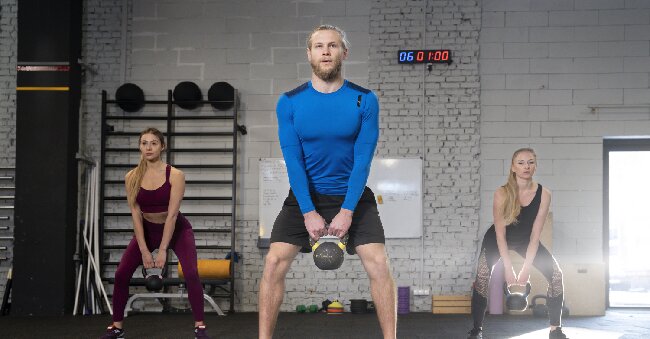
The Ultimate Kettlebell Weight Guide: 5 Expert Tips to Choose the Right Weight
Looking to spice up your workout routine? Kettlebell workouts might just be the answer you’ve been looking for.
In this comprehensive guide, we will explore everything you need to know about kettlebells – from their history to the benefits they offer.
Learn how to choose the right kettlebell weight, the different types of exercises you can do, safety tips to keep in mind, and how to incorporate kettlebell workouts into your fitness routine.
Stay tuned to hear what the experts have to say about kettlebell workouts!
What Are Kettlebells?
Kettlebells are a type of weight training equipment that resembles a cannonball with a handle attached. They are versatile tools used in strength training and conditioning exercises.
The unique design of kettlebells allows for dynamic movements and an emphasis on whole-body exercises. Unlike traditional dumbbells, kettlebells provide an offset center of gravity that requires more stabilization and engagement from the core muscles during workouts. This design not only enhances balance and coordination but also helps in promoting functional strength, making them a popular choice among athletes and fitness enthusiasts. Incorporating kettlebell exercises into your routine can boost cardiovascular endurance, improve flexibility, and build muscle mass efficiently.
History of Kettlebells
The history of kettlebells dates back centuries, originating in Russia as a tool for weighing crops. Over time, kettlebells evolved into a popular strength and conditioning tool used by fitness experts worldwide.
These iconic weights were utilized by Russian strongmen and the Soviet military for their exceptional effectiveness in developing strength and endurance. The unique design of kettlebells, with a handle attached to a ball-shaped weight, allows for dynamic movements that engage multiple muscle groups simultaneously. As fitness experts recognized the benefits of kettlebell training, it gained traction in the Western world during the late 20th century. Today, kettlebell workouts are an integral part of functional training programs in gyms and fitness centers globally.
What Are the Benefits of Kettlebell Workouts?
Engaging in kettlebell workouts offers a comprehensive array of benefits, including improved strength, muscle endurance, cardiovascular health, and enhanced functional movement.
These versatile and dynamic exercises not only help in building lean muscle mass and increasing overall strength but also play a significant role in enhancing muscle endurance. By incorporating kettlebell routines into your fitness regimen, you can experience improved cardiovascular health due to the high-intensity nature of the workouts. The functional movements involved in kettlebell exercises can lead to greater mobility, flexibility, and agility in your day-to-day activities.
Full-body Workout
Utilizing kettlebells provides a holistic full-body workout experience that targets multiple muscle groups simultaneously, making it an efficient fitness regimen for overall muscle development and toning.
- By incorporating a variety of kettlebell exercises such as swings, squats, and presses, individuals can engage their core, legs, arms, and back, creating a comprehensive workout that maximizes calorie burning and strength building.
- These dynamic movements not only enhance muscular endurance but also improve cardiovascular fitness, offering a well-rounded approach to physical conditioning.
The versatility of kettlebells allows for seamless progression by adjusting weights and repetitions, ensuring continued challenge and growth in muscle toning and strength gains.
Improves Strength and Muscle Endurance
Regular kettlebell training enhances both strength and muscle endurance by requiring proper technique and engagement of stabilizing muscles, resulting in functional and practical strength gains.
When utilizing kettlebells, individuals experience improvements in core strength, balance, and coordination due to the dynamic nature of the exercises. By targeting multiple muscle groups simultaneously, kettlebell workouts promote a comprehensive approach to building strength and endurance. The ballistic movements involved in kettlebell training not only build muscle but also enhance cardiovascular fitness, making it a time-efficient and effective workout option.
Mastering the correct form is crucial to prevent injury and maximize the benefits of each exercise, underscoring the importance of guidance from a qualified trainer for optimal results.
Increases Cardiovascular Health
Kettlebell exercises contribute to improved cardiovascular health by combining strength training with dynamic movements that elevate heart rate, enhancing overall endurance and promoting efficient oxygen utilization through focused breathing techniques.
This unique form of workout not only burns calories but also helps in developing cardiovascular fitness by engaging multiple muscle groups simultaneously. The continuous motion involved in kettlebell exercises boosts heart health by increasing circulation and strengthening the heart muscle. The emphasis on proper breathing techniques during kettlebell routines enhances lung capacity and oxygen delivery to the body, supporting improved overall endurance levels for better performance in various physical activities.
Incorporating kettlebell workouts into your fitness routine can lead to significant improvements in cardiovascular health over time.
Enhances Functional Movement
Kettlebell training focuses on enhancing functional movements by targeting core engagement, mobility, and stability, facilitating improved body mechanics and performance in daily activities.
By incorporating kettlebells into your workouts, you can experience a significant boost in overall strength and power. The unique shape and off-center weight distribution of kettlebells force your body to engage multiple muscle groups simultaneously, leading to better coordination and balance.
These dynamic movements help bridge the gap between strength training and real-life movements, preparing your body for the various physical demands of everyday life. The swinging and ballistic nature of kettlebell exercises also contribute to increased cardiovascular endurance and calorie burning, making them a versatile tool for holistic fitness.
How to Choose the Right Kettlebell Weight?
Selecting the appropriate kettlebell weight involves considering your current fitness level, defining your workout goals, and ensuring proper form and technique to prevent injury and maximize training effectiveness.
In addition to these factors, it is crucial to choose a kettlebell size that aligns with your strength and skill level. Starting with a weight that is too heavy can lead to improper form and potential strain on your muscles. For beginners, it is recommended to begin with a lighter weight to focus on mastering the movements and building endurance before gradually increasing the load. This gradual progression not only reduces the risk of injury but also allows for sustainable growth and improved performance over time. Remember, the key is to challenge yourself appropriately while still maintaining control and safety during your kettlebell workouts.
Consider Your Current Fitness Level
Assessing your current fitness level is crucial in determining the appropriate kettlebell size to avoid strain and ensure gradual progression as you advance in your training journey.
Understanding your fitness level allows you to select the right kettlebell weight that suits your strength and capabilities. Starting with a kettlebell that is too heavy can lead to improper form and potential injuries, while one that is too light may hinder your progress. By matching the kettlebell size to your current fitness level, you set a solid foundation for improvement. As your strength and endurance increase, you can gradually advance to heavier kettlebells, challenging yourself safely and effectively.
Determine Your Goals
Establishing clear fitness goals is essential for choosing the right kettlebell weight that aligns with your strength objectives, program design, and desired success outcomes in your training regimen.
By setting concrete goals in your kettlebell training, you provide yourself with direction and purpose, paving the way for structured progress and continuous improvement.
Your strength aspirations play a crucial role in determining the appropriate weight selection for each exercise, ensuring that you challenge yourself effectively without risking injury or burnout.
Aligning your goals with specific program design considerations, such as the frequency of training sessions and the intensity of workouts, helps in creating a tailored approach that suits your individual needs.
Monitoring key success metrics, such as strength gains, endurance levels, and overall performance, allows you to track your progress and adjust your training regimen accordingly to achieve optimal results.
Choose the Right Shape and Handle Size
Selecting kettlebells with the appropriate shape and handle size is vital for ensuring a comfortable grip, proper form execution, and effective engagement during various kettlebell exercises.
The shape and handle size of a kettlebell play a crucial role in determining how well you can perform exercises such as swings, snatches, and Turkish get-ups. A properly sized handle allows for a secure grip, reducing the risk of slippage and ensuring stability throughout the movement. The shape of the kettlebell can impact the trajectory of your swings and the placement of your hand during cleans and presses. By choosing kettlebells that are suited to your hand size and exercise preferences, you can enhance your workout experience and optimize your results.
What Are the Different Types of Kettlebell Exercises?
Kettlebell exercises encompass a variety of movements such as swings, cleans, presses, snatches, and Turkish get-ups, each targeting different muscle groups and offering unique training benefits.
- Swings are fantastic for working the entire body, particularly the posterior chain, including the glutes, hamstrings, and lower back.
- Cleans are excellent for enhancing grip strength and explosive power.
- Presses target the shoulders, triceps, and core, aiding in shoulder stability.
- Snatches are dynamic and engage multiple muscle groups simultaneously, promoting cardiovascular endurance.
- Turkish get-ups are a full-body exercise that enhances stability, mobility, and coordination.
Variations like single-arm swings, clean and press combos, or overhead snatches provide versatility and allow for progressive challenge in kettlebell training.
Swings
Kettlebell swings are dynamic exercises that emphasize power generation from the hips, engaging the shoulders, back, and core to execute controlled and effective swinging motions.
This powerful movement relies on the explosive hip drive to propel the kettlebell forward, activating the glutes, hamstrings, and lower back for an efficient full-body workout.
The swinging motion also demands strong shoulder stability as the arms control the trajectory of the kettlebell, leading to increased shoulder strength and endurance over time.
The core muscles are continuously engaged to stabilize the body and control the momentum of the swing, resulting in improved core strength and overall functional fitness.
Cleans
Kettlebell cleans involve a fluid motion of lifting the weight to shoulder height, emphasizing proper form, endurance building, and targeted arm muscle engagement for a complete workout experience.
This dynamic exercise not only enhances overall strength but also helps in improving coordination and stability. By focusing on maintaining a strong core and utilizing the legs to propel the kettlebell upwards, individuals can achieve a full-body workout in just one movement. The activation of various muscle groups simultaneously contributes to calorie burning and efficient time management during workout sessions. Correct execution of kettlebell cleans also aids in posture correction and reinforces proper body mechanics, making it a functional exercise that translates well to everyday movements.
Presses
Kettlebell presses target the shoulder muscles to build strength and stability, requiring controlled movements, proper shoulder alignment, and a focus on repetitions to enhance muscle endurance.
By incorporating kettlebell presses into your workout routine, you not only engage the shoulder muscles but also promote overall upper body strength development. The dynamic nature of this exercise helps in targeting multiple muscle groups simultaneously, aiding in boosting your functional strength. The controlled repetitions involved in kettlebell presses contribute to improving muscle endurance and enhancing your overall fitness level. It is crucial to maintain proper alignment throughout the movement to prevent strain or injury, ensuring that you get the most out of each repetition for optimal results.
Snatches
Kettlebell snatches are explosive movements that require proper technique, power generation, and swift transitions to lift the weight overhead, engaging multiple muscle groups for a high-intensity workout.
The key to mastering kettlebell snatches lies in the precise coordination of movements, starting from the hip hinge and progressing into a powerful overhead swing. This exercise demands a perfect balance of strength and agility, as the transition from the swing to the overhead position requires a quick and controlled movement. Engaging the core, shoulders, and legs is essential for stability and power generation throughout the snatch. By focusing on form and explosiveness, individuals can experience a full-body workout that enhances strength, endurance, and overall athletic performance.
Turkish Get-Ups
Turkish get-ups are complex kettlebell exercises that enhance stability, core engagement, and full-body mobility through a series of controlled movements from lying to standing positions, promoting functional strength development.
By focusing on the intricate coordination required to transition smoothly between different positions during a Turkish get-up, individuals can significantly improve their proprioception and spatial awareness. This exercise also targets numerous muscle groups simultaneously, leading to a more holistic approach to strength training. The continuous engagement of the core muscles throughout the movement not only increases core strength but also enhances overall body stability. The dynamic nature of Turkish get-ups aids in promoting flexibility and joint mobility, making it an excellent choice for individuals looking to improve their overall movement quality.
What Are the Safety Tips for Kettlebell Workouts?
Ensuring safety during kettlebell workouts involves warming up adequately, maintaining proper form, avoiding common mistakes, starting with lighter weights, and prioritizing injury prevention through mindful training practices.
Prior to engaging in any kettlebell exercise, it’s crucial to perform a dynamic warm-up routine like leg swings, arm circles, and light cardio to prep the muscles for movement. Correct form execution is key to preventing injuries and maximizing the effectiveness of each exercise. It’s essential to keep the core engaged, shoulders back, and hips square throughout the movements. To avoid mistakes, focus on mastering the proper technique before increasing the weight used. Gradually progressing to heavier kettlebells reduces the risk of strains and overuse injuries, allowing for gradual strength gains.
Warm Up Properly
Properly warming up before kettlebell workouts is crucial for preparing the body, enhancing flexibility, raising core temperature, and promoting mindful breathing techniques to optimize performance and reduce injury risks.
A comprehensive warm-up routine acts as a catalyst for engaging the muscles and joints, allowing them to move through a full range of motion effectively. By increasing the flexibility of muscles and tendons, the risk of strains and muscle tears during intense kettlebell exercises is significantly reduced. Elevating the core temperature through dynamic warm-up activities helps improve blood circulation and oxygen delivery to muscles, which is essential for generating energy and enhancing overall performance. Incorporating specific breathing techniques during the warm-up phase helps center the mind, increase focus, and improve coordination, setting a strong foundation for a successful kettlebell training session.
Use Proper Form
Maintaining proper form during kettlebell exercises is essential to prevent injuries, optimize muscle engagement, and ensure effective technique execution, focusing on core stability and alignment for safe and efficient workouts.
By maintaining the correct posture and alignment, individuals can target specific muscle groups effectively, leading to greater strength gains and reduced risk of strain.
When performing exercises such as kettlebell swings or Turkish get-ups, paying attention to form helps in engaging the core muscles, promoting stability and balance throughout the movements.
Prioritizing correct form not only maximizes the benefits of the workout but also minimizes the chances of overexertion and injury, making it crucial for long-term progress and physical well-being.
Start with Lighter Weights
Initial kettlebell training should involve lighter weights to master proper technique, focus on repetitions, gradually introduce sets, and progress in weight gradually to prevent strains and promote skill development.
Starting with light kettlebells allows beginners to practice essential movements with correct form, reducing the risk of injury. Emphasizing repetition helps in reinforcing muscle memory and building endurance. Introducing sets gradually helps in managing fatigue and developing stamina. As one becomes more adept, progressing to heavier weights challenges the body to adapt and grow stronger, leading to continual skill advancement in kettlebell training.
Listen to Your Body
It is crucial to listen to your body’s signals during kettlebell workouts, recognizing fatigue, discomfort, or pain to prevent injuries, prioritize rest and recovery, and maintain a sustainable training routine.
By being attuned to how your body responds to various kettlebell exercises, you can adjust your workout intensity and duration accordingly, reducing the risk of overtraining or strain.
Incorporating adequate rest periods between sessions is essential to allow muscles time to recover and adapt to the physical demands.
Implementing effective recovery strategies such as proper hydration, nutrition, and stretching can enhance performance and prevent muscle soreness.
Building a foundation of body awareness in your training regimen sets the stage for long-term progress and injury prevention.
How to Incorporate Kettlebell Workouts into Your Fitness Routine?
Integrating kettlebell workouts into your fitness routine entails designing a structured program with varied exercises, setting achievable goals, fostering motivation, and ensuring consistency for optimal results.
This diversity in program design allows you to target different muscle groups and ensures a well-rounded workout experience. By incorporating a mix of strength, endurance, and conditioning exercises, you can work towards improved overall fitness levels.
It’s essential to establish clear, measurable goals to track progress and stay motivated. Finding what drives you, whether it’s improving strength, losing weight, or boosting endurance, can help maintain enthusiasm for your kettlebell routine.
Consistency is key in seeing long-term benefits, so creating a schedule and sticking to it will aid in achieving your fitness aspirations.
What Do Experts Say About Kettlebell Workouts?
Experts in the fitness industry advocate for kettlebell workouts, offering pro tips on technique refinement, exercise variations, program recommendations, and safety precautions to maximize workout efficiency and results.
One key recommendation from experts is to ensure proper form and technique when performing kettlebell exercises to prevent injury and optimize benefits. Professionals emphasize the importance of gradually increasing weights and not compromising form for heavier loads. They also suggest incorporating a mix of compound movements and isolation exercises to target different muscle groups effectively. Taking adequate rest between sessions and listening to your body’s signals are crucial aspects advised by experts to avoid overtraining and burnout in kettlebell training.
External Resource: https://nutroone.com/en/product-category/weight-train/kettlebell/




No Comments